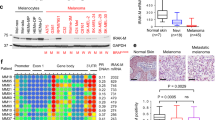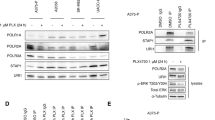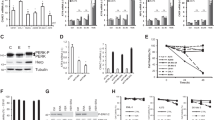Abstract
Effective treatment of malignant melanoma with the tumor-selective death ligand tumor necrosis-related apoptosis-inducing ligand (TRAIL) is curtailed by the fact that many melanoma cell lines are a priori resistant against TRAIL-induced apoptosis. By investigating 18 melanoma cell lines, we show that TRAIL susceptibility is completely independent of the tumor progression stage but can be positively stimulated by co-exposure to a sublethal ultraviolet B light (UVB) dose, providing an excellent tool to study the mechanism underlying TRAIL resistance. TRAIL resistance could be linked to the ratio of x-linked inhibitor of apoptosis proteins (xIAP) and caspase-3 levels within the cell. UVB-induced sensitization coincides with enhanced xIAP degradation, allowing full caspase-3 processing and activation. It is also accompanied by concomitant IκBα degradation, resulting in nuclear factor-κB (NF-κB)-dependent transcriptional repression of xIAP. Loss of xIAP in turn was reduced upon overexpression of an IκBα super-repressor, thus NF-κB activation seems to be responsible for differential regulation of xIAP and consequently determines TRAIL susceptibility. As xIAP-mediated blockade of apoptosis seems to be the dominant cause of TRAIL resistance of all melanoma cell lines investigated here, our data suggest that direct chemical xIAP inhibition or combination treatment with DNA-damaging agents may offer new therapeutic strategies to generally sensitize melanoma toward TRAIL-induced apoptosis.
This is a preview of subscription content, access via your institution
Access options
Subscribe to this journal
Receive 50 print issues and online access
$259.00 per year
only $5.18 per issue
Buy this article
- Purchase on Springer Link
- Instant access to full article PDF
Prices may be subject to local taxes which are calculated during checkout












Similar content being viewed by others
References
Amiri KI, Richmond A . (2005). Role of nuclear factor-kappa B in melanoma. Cancer Metastasis Rev 24: 301–313.
Bouralexis S, Findlay DM, Atkins GJ, Labrinidis A, Hay S, Evdokiou A . (2003). Progressive resistance of BKT-143 osteosarcoma cells to Apo2L/TRAIL-induced apoptosis is mediated by acquisition of DcR2/TRAIL4 expression: resensitization with chemotherapy. Br J Cancer 89: 206–214.
Bullani RR, Huard B, Viard-Leveugle I, Byers HR, Irmler M, Saurat JH et al. (2001). Selective expression of FLIP in malignant melanocytic skin lesions. J Invest Dermatol 117: 360–364.
Campbell KJ, Rocha S, Perkins ND . (2004). Active repression of antiapoptotic gene expression by RelA(p65) NF-kappaB. Mol Cell 13: 853–865.
Chawla-Sarkar M, Bae SI, Reu FJ, Jacobs BS, Lindner DJ, Borden EC . (2004). Downregulation of Bcl-2, FLIP or IAPs (XIAP and survivin) by siRNAs sensitizes resistant melanoma cells to APO2L/TRAIL-induced apoptosis. Cell Death Differ 11: 915–923.
Cheung HH, Plenchette S, Kern CJ, Mahoney DJ, Korneluk RG . (2008). The RING domain of cIAP1 mediates the degradation of RING-bearing inhibitor of apoptosis proteins by distinct pathways. Mol Biol Cell 19: 2729–2740.
Clark Jr WH . (1991). Human cutaneous malignant melanoma as a model for cancer. Cancer Metastasis Rev 10: 83–88.
Degli-Esposti MA, Dougall WC, Smolak PJ, Waugh JY, Smith CA, Goodwin RG . (1997a). The novel receptor TRAIL-R4 induces NF-kappaB and protects against TRAIL-mediated apoptosis, yet retains an incomplete death domain. Immunity 7: 813–820.
Degli-Esposti MA, Smolak PJ, Walczak H, Waugh J, Huang CP, DuBose RF et al. (1997b). Cloning and characterization of TRAIL-R3, a novel member of the emerging TRAIL receptor family. J Exp Med 186: 1165–1170.
Delhase M, Hayakawa M, Chen Y, Karin M . (1999). Positive and negative regulation of IkappaB kinase activity through IKKbeta subunit phosphorylation. Science 284: 309–313.
Dohi T, Okada K, Xia F, Wilford CE, Samuel T, Welsh K et al. (2004). An IAP–IAP complex inhibits apoptosis. J Biol Chem 279: 34087–34090.
Eckelman BP, Salvesen GS, Scott FL . (2006). Human inhibitor of apoptosis proteins: why XIAP is the black sheep of the family. EMBO Rep 7: 988–994.
Ehrhardt H, Fulda S, Schmid I, Hiscott J, Debatin KM, Jeremias I . (2003). TRAIL induced survival and proliferation in cancer cells resistant towards TRAIL-induced apoptosis mediated by NF-kappaB. Oncogene 22: 3842–3852.
Elder DE, Clark Jr WH, Elenitsas R, Guerry D, Halpern AC . (1993). The early and intermediate precursor lesions of tumor progression in the melanocytic system: common acquired nevi and atypical (dysplastic) nevi. Semin Diagn Pathol 10: 18–35.
Falschlehner C, Emmerich CH, Gerlach B, Walczak H . (2007). TRAIL signalling: decisions between life and death. Int J Biochem Cell Biol 39: 1462–1475.
Flaherty KT . (2006). Chemotherapy and targeted therapy combinations in advanced melanoma. Clin Cancer Res 12: 2366s–2370s.
Franco AV, Zhang XD, Van Berkel E, Sanders JE, Zhang XY, Thomas WD et al. (2001). The role of NF-kappa B in TNF-related apoptosis-inducing ligand (TRAIL)-induced apoptosis of melanoma cells. J Immunol 166: 5337–5345.
Ganten TM, Koschny R, Sykora J, Schulze-Bergkamen H, Buchler P, Haas TL et al. (2006). Preclinical differentiation between apparently safe and potentially hepatotoxic applications of TRAIL either alone or in combination with chemotherapeutic drugs. Clin Cancer Res 12: 2640–2646.
Geserick P, Drewniok C, Hupe M, Haas TL, Diessenbacher P, Sprick MR et al. (2007). Suppression of cFLIP is sufficient to sensitize human melanoma cell to TRAIL- and CD95L-mediated apoptosis. Oncogene 27: 3211–3220.
Griffith TS, Chin WA, Jackson GC, Lynch DH, Kubin MZ . (1998). Intracellular regulation of TRAIL-induced apoptosis in human melanoma cells. J Immunol 161: 2833–2840.
Jeremias I, Debatin KM . (1998). TRAIL induces apoptosis and activation of NFkappaB. Eur Cytokine Netw 9: 687–688.
Kashkar H, Deggerich A, Seeger JM, Yazdanpanah B, Wiegmann K, Haubert D et al. (2007). NF-kappaB-independent down-regulation of XIAP by bortezomib sensitizes HL B cells against cytotoxic drugs. Blood 109: 3982–3988.
Kashkar H, Haefs C, Shin H, Hamilton-Dutoit SJ, Salvesen GS, Krönke M et al. (2003). XIAP-mediated caspase inhibition in Hodgkin's lymphoma-derived B cells. J Exp Med 198: 341–347.
Koschny R, Walczak H, Ganten TM . (2007). The promise of TRAIL—potential and risks of a novel anticancer therapy. J Mol Med 85: 923–935.
Kothny-Wilkes G, Kulms D, Pöppelmann B, Luger TA, Kubin M, Schwarz T . (1998). Interleukin-1 protects transformed keratinocytes from tumor necrosis factor-related apoptosis-inducing ligand. J Biol Chem 273: 29247–29253.
Kurbanov BM, Geilen CC, Fecker LF, Orfanos CE, Eberle J . (2005). Efficient TRAIL-R1/DR4-mediated apoptosis in melanoma cells by tumor necrosis factor-related apoptosis-inducing ligand (TRAIL). J Invest Dermatol 125: 1010–1019.
Larribere L, Khaled M, Tartare-Deckert S, Busca R, Luciano F, Bille K et al. (2004). PI3K mediates protection against TRAIL-induced apoptosis in primary human melanocytes. Cell Death Differ 11: 1084–1091.
Lasithiotakis KG, Leiter U, Gorkievicz R, Eigentler T, Breuninger H, Metzler G et al. (2006). The incidence and mortality of cutaneous melanoma in Southern Germany: trends by anatomic site and pathologic characteristics: 1076-2003. Cancer 107: 1331–1339.
Li Q, Verma IM . (2002). NF-kappaB regulation in the immune system. Nat Rev Immunol 2: 725–734.
Meier F, Satyamoorthy K, Nesbit M, Hsu MY, Schittek B, Garbe C et al. (1998). Molecular events in melanoma development and progression. Front Biosci 3: D1005–D1010.
Meier F, Schittek B, Busch S, Garbe C, Smalley K, Satyamoorthy K et al. (2005). The RAS/RAF/MEK/ERK and PI3K/AKT signalling pathways present molecular targets for the effective treatment of advanced melanoma. Front Biosci 10: 2986–3001.
Merino D, Lalaoui N, Morizot A, Schneider P, Solary E, Micheau O . (2006). Differential inhibition of TRAIL-mediated DR5-DISC formation by decoy receptors 1 and 2. Mol Cell Biol 26: 7046–7055.
Merino D, Lalaoui N, Morizot A, Solary E, Micheau O . (2007). TRAIL in cancer therapy: present and future challenges. Expert Opin Ther Targets 11: 1299–1314.
Micheau O, Lens S, Gaide O, Alevizopoulos K, Tschopp J . (2001). NF-kappaB signals induce the expression of c-FLIP. Mol Cell Biol 21: 5299–5305.
Micheau O, Merino D . (2004). Controlling TRAIL-mediated caspase-3 activation. Leukemia 18: 1578–1580.
Micheau O, Thome M, Schneider P, Holler N, Tschopp J, Nicholson DW et al. (2002). The long form of FLIP is an activator of caspase-8 at the Fas death-inducing signaling complex. J Biol Chem 277: 45162–45171.
Panner A, James CD, Berger MS, Pieper RO . (2005). mTOR controls FLIPS translation and TRAIL sensitivity in glioblastoma multiforme cells. Mol Cell Biol 25: 8809–8823.
Pitti RM, Marsters SA, Ruppert S, Donahue CJ, Moore A, Ashkenazi A . (1996). Induction of apoptosis by Apo-2 ligand, a new member of the tumor necrosis factor cytokine family. J Biol Chem 271: 12687–12690.
Pöppelmann B, Klimmek K, Strozyk E, Voss R, Schwarz T, Kulms D . (2005). NFκB-dependent down-regulation of tumor necrosis factor receptor-associated proteins contributes to interleukin-1-mediated enhancement of UVB-induced apoptosis. J Biol Chem 280: 15635–15643.
Ricci MS, Jin Z, Dews M, Yu D, Thomas-Tikhonenko A, Dicker DT et al. (2004). Direct repression of FLIP expression by c-myc is a major determinant of TRAIL sensitivity. Mol Cell Biol 24: 8541–8555.
Riccioni R, Pasquini L, Mariani G, Saulle E, Rossini A, Diverio D et al. (2005). TRAIL decoy receptors mediate resistance of acute myeloid leukemia cells to TRAIL. Haematologica 90: 612–624.
Shi RX, Ong CN, Shen HM . (2005). Protein kinase C inhibition and x-linked inhibitor of apoptosis protein degradation contribute to the sensitization effect of luteolin on tumor necrosis factor-related apoptosis-inducing ligand-induced apoptosis in cancer cells. Cancer Res 65: 7815–7823.
Sohn D, Totzke G, Essmann F, Schulze-Osthoff K, Levkau B, Janicke RU . (2006). The proteasome is required for rapid initiation of death receptor-induced apoptosis. Mol Cell Biol 26: 1967–1978.
Sprick MR, Weigand MA, Rieser E, Rauch CT, Juo P, Blenis J et al. (2000). FADD/MORT1 and caspase-8 are recruited to TRAIL receptor 1 and 2 and are essential for apoptosis mediated by TRAIL receptor 2. Immunity 12: 599–609.
Strozyk E, Pöppelmann B, Schwarz T, Kulms D . (2006). Differential effects of NF-kappaB on apoptosis induced by DNA-damaging agents: The type of DNA damage determines the final outcome. Oncogene 25: 6239–6251.
Ueda Y, Richmond A . (2006). NF-kappaB activation in melanoma. Pigment Cell Res 19: 112–124.
Wajant H, Moosmayer D, Wuest T, Bartke T, Gerlach E, Schonherr U et al. (2001). Differential activation of TRAIL-R1 and -2 by soluble and membrane TRAIL allows selective surface antigen-directed activation of TRAIL-R2 by soluble TRAIL derivative. Oncogene 20: 4101–4106.
Walczak H, Miller RE, Ariail K, Gliniak B, Griffith TS, Kubin M et al. (1999). Tumoricidal activity of tumor necrosis factor-related apoptosis-inducing ligand in vivo. Nat Med 5: 157–163.
Wang CY, Mayo MW, Korneluk RG, Goeddel DV, Baldwin Jr AS . (1998). NF-kappaB antiapoptosis: induction of TRAF1 and TRAF2 and c-IAP1 and c-IAP2 to suppress caspase-8 activation. Science 281: 1680–1683.
Wang Y, Chan S, Tsang BK . (2002). Involvement of inhibitory nuclear factor-kappaB (NFkappaB)-independent NFkappaB activation in the gonadotropic regulation of X-linked inhibitor of apoptosis expression during ovarian follicular development in vitro. Endocrinology 143: 2732–2740.
Wiley SR, Schooley K, Smolak PJ, Din WS, Huang CP, Nicholl JK et al. (1995). Identification and characterization of a new member of the TNF family that induces apoptosis. Immunity 3: 673–682.
Xiao C, Yang BF, Song JH, Schulman H, Li L, Hao C . (2005). Inhibition of CaMKII-mediated cFLIP expression sensitizes malignant melanoma cells to TRAIL-induced apoptosis. Exp Cell Res 304: 244–255.
Zeise E, Weichenthal M, Schwarz T, Kulms D . (2004). Resistance of human melanoma cells against the death ligand TRAIL is reversed by ultraviolet-B radiation via downregulation of FLIP. J Invest Dermatol 123: 746–754.
Zhang XD, Wu JJ, Gillespie S, Borrow J, Hersey P . (2006). Human melanoma cells selected for resistance to apoptosis by prolonged exposure to tumor necrosis factor-related apoptosis-inducing ligand are more vulnerable to necrotic cell death induced by cisplatin. Clin Cancer Res 12: 1355–1364.
Acknowledgements
We thank Amgen/Genentech (Seattle, USA) for providing TRAIL antibodies. We are grateful to F Meier (Department of Dermato-Oncology, University of Tübingen) for providing melanoma cell lines and melanocytes, H Walczak (Tumour Immunology Unit, Imperial College London) for supplying iz-TRAIL and to H Kashkar (Institute for Medical Microbiology, University of Cologne) for the xIAP-pEGFPC3 construct. This study was funded by Deutsche Krebshilfe 106699.
Author information
Authors and Affiliations
Corresponding author
Additional information
Supplementary Information accompanies the paper on the Oncogene website (http://www.nature.com/onc)
Supplementary information
Rights and permissions
About this article
Cite this article
Thayaparasingham, B., Kunz, A., Peters, N. et al. Sensitization of melanoma cells to TRAIL by UVB-induced and NF-κB-mediated downregulation of xIAP. Oncogene 28, 345–362 (2009). https://doi.org/10.1038/onc.2008.397
Received:
Revised:
Accepted:
Published:
Issue Date:
DOI: https://doi.org/10.1038/onc.2008.397
Keywords
This article is cited by
-
Systemic network analysis identifies XIAP and IκBα as potential drug targets in TRAIL resistant BRAF mutated melanoma
npj Systems Biology and Applications (2018)
-
IgG-single-chain TRAIL fusion proteins for tumour therapy
Scientific Reports (2018)
-
Bortezomib sensitises TRAIL-resistant HPV-positive head and neck cancer cells to TRAIL through a caspase-dependent, E6-independent mechanism
Cell Death & Disease (2014)
-
Development of a human three-dimensional organotypic skin-melanoma spheroid model for in vitro drug testing
Cell Death & Disease (2013)
-
Caspase-3 cleaves XIAP in a positive feedback loop to sensitize melanoma cells to TRAIL-induced apoptosis
Oncogene (2011)



